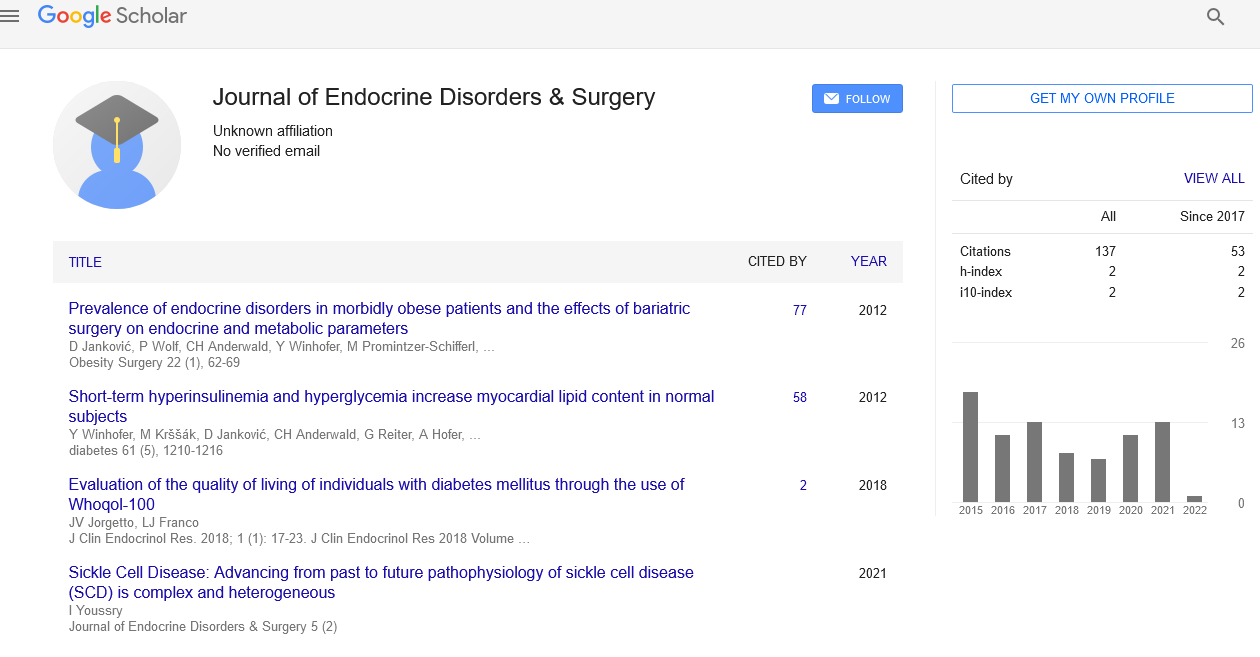Diabetes and its types
Received: 24-Jun-2022, Manuscript No. PULJEDS-22-5411; Editor assigned: 26-Jun-2022, Pre QC No. PULJEDS-22-5411 (PQ); Accepted Date: Jul 31, 2022; Reviewed: 30-Jun-2022 QC No. PULJEDS-22-5411 (Q); Revised: 30-Jul-2022, Manuscript No. PULJEDS-22-5411 (R); Published: 01-Aug-2022, DOI: 10.37532/ puljeds.2022.6(4).49-50
Citation: James A. Diabetes and it’s types. J. Endocr Disord Surg. 2022; 6(4) :49-50
This open-access article is distributed under the terms of the Creative Commons Attribution Non-Commercial License (CC BY-NC) (http://creativecommons.org/licenses/by-nc/4.0/), which permits reuse, distribution and reproduction of the article, provided that the original work is properly cited and the reuse is restricted to noncommercial purposes. For commercial reuse, contact reprints@pulsus.com
Introduction
Diabetes is a disorder that makes it difficult for the body to process blood sugar, often known as blood glucose. Diabetes comes in a variety of forms, each with a unique course of therapy. There are numerous types of diabetes, and each has a unique management strategy. Not all types of diabetes are brought on by obesity or a sedentary lifestyle. Some have existed from childhood. Type 1, type 2, and gestational diabetes are the most prevalent kinds of diabetes.
Type 1 diabetes
When the body is unable to manufacture insulin. The hormone insulin is in charge of metabolizing blood sugar for usage by the body as needed. Insulin must be regularly administered to people with type 1 diabetes Trusted Source. People can use an insulin pump or shots to do this. Type 1 diabetes does not have a treatment. After being diagnosed, a person with diabetes needs to frequently check their blood sugar levels, take insulin, and make some lifestyle adjustments to help control the illness. People with type 1 diabetes who successfully control their blood sugar levels can prevent major problems.
Type 2 diabetes
Insulin therapy may or may not be necessary for someone with type 2 diabetes. Medication, along with dietary and activity modifications, can frequently help control the disease. Anyone can get type 2 diabetes, including adults and children.
Gestational diabetes
An individual develops gestational diabetes during pregnancy when their sensitivity to insulin decreases. Gestational diabetes affects 1%- 12% of pregnancies each year, according to the Centers for Disease Control and Prevention (CDC). The problem is more likely to develop in people who are overweight before getting pregnant. A person's chance of getting high blood pressure during pregnancy can be increased by gestational diabetes.
Prediabetes
When a person's blood sugar levels are increased but not high enough to be diagnosed with diabetes, it is referred to as prediabetes or borderline diabetes. Despite not typically exhibiting the signs of complete diabetes, those with prediabetes have an increased chance of acquiring type 2 diabetes.
Prevention
Type 1 diabetes cannot be avoided. However, take a few precautions to help prevent type 2 diabetes. Among the measures to fend against type 2 diabetes.
1) Maintaining a moderate weight.
2) Eating a balanced diet low in added sugars, saturated fats, and processed foods.
3) Exercising regularly.
4) Before being pregnant, a person should maintain a healthy weight to lower their risk of acquiring gestational diabetes. Despite the fact that these actions can be beneficial, it's crucial to remember that type 2 or gestational diabetes can still occur in individuals.
Advice on diet and exercise
If a person is diagnosed with diabetes, a doctor will frequently advise making lifestyle adjustments to assist in healthy weight management. A patient with diabetes or prediabetes may be referred to a nutritionist by their physician. People with diabetes can control their illness and live active, balanced lives with the assistance of an expert.
The actions a person with diabetes can take to maintain their health include
1) Eating a diet rich in healthful, fresh foods, such as nuts, whole grains, fruits, vegetables, lean proteins, low-fat dairy, and lean sources of oil.
2) Avoiding foods high in sugar, such as sweetened sodas, fried foods, and sweet sweets, which deliver empty calories or calories without any nutritious value.
3) Refraining from drinking excessive amounts of alcohol or keeping intake to less than one drink a day for females or two drinks a day for males.
4) Engaging in at least 30 minutes of exercise per day on at least 5 days of the week, such as walking, aerobics, riding a bike, or swimming.
5) Recognizing signs of low blood sugar when exercising, including dizziness, confusion, weakness, and profuse sweating.
Using insulin
Insulin must be administered to all type 1 diabetics and some type 2 diabetics in order to prevent dangerously high blood sugar levels. There are numerous insulin subtypes, and the majority of them are categorised according to how long they last.
There are several types of insulin, including mixed, rapid-acting, short-acting, intermediate-acting, and long-acting. Long-acting insulin is sometimes used to keep blood sugar levels consistently low. Others may mix different insulin kinds or short-acting insulin. A person will often check their blood sugar levels to decide how much insulin they need, regardless of the type. A person can use a blood glucose monitor, which requires pricking their skin, or a combination of a Continuous Blood Glucose Monitor (CGM) and skin pricks to check their blood sugar levels. A CGM regularly measures blood sugar levels throughout the day. They can assist someone in changing their medication if necessary. A person can only determine their blood sugar levels by self-monitoring. Unless a person suspects severely low sugar and believes they require a rapid infusion of glucose, assuming the level based on any physical symptoms that arise may be harmful





